AMD’s Radeon HD 5570: Low Profile, Higher Performance
by Ryan Smith on February 9, 2010 12:00 AM EST- Posted in
- GPUs
Power, Temperature, & Noise
As a note here, since NVIDIA does not offer a reference GT 240, we’re using our Asus 512MB GDDR5 GT 240 as our reference 240.
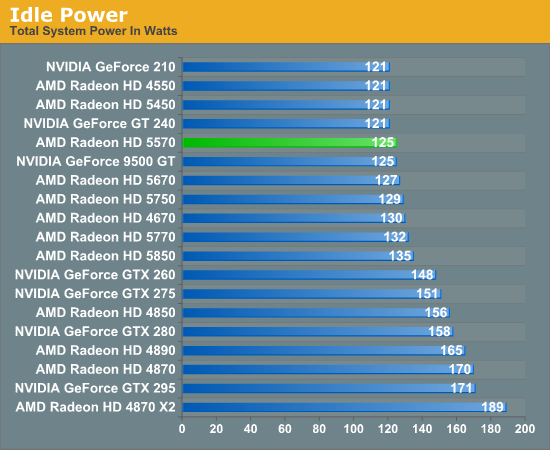
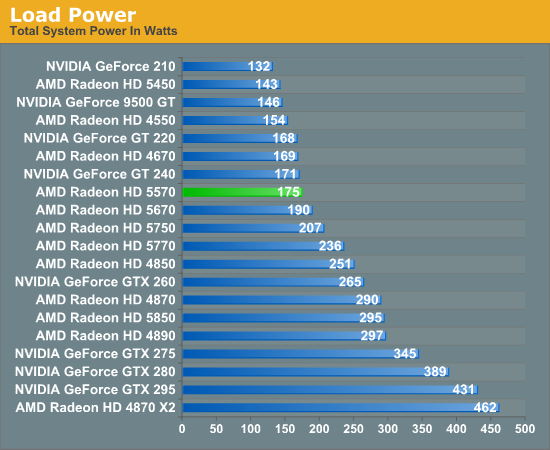
With a 42W TDP and 9.7W idle power rating, it should come as no surprise that the 5570 comes in between the 5450 and 5670 at both power measurements. The GT 240 is the biggest winner here, beating even the 5570. However this is likely due to differences in how AMD and NVIDIA throttle their cards under FurMark.
In terms of performance per watt, the 5570 falls in the same general range as the 4670 and the GT 240. This also gives us an idea of where the cut-off is for what can be done with a low-profile card – at 15W more under load, the 5670 basically marks the start of a whole new class of cards.
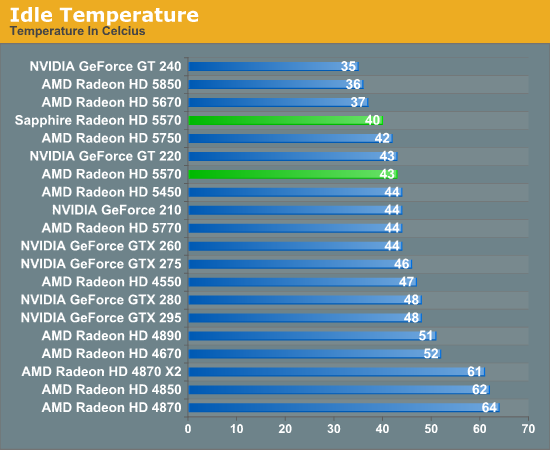
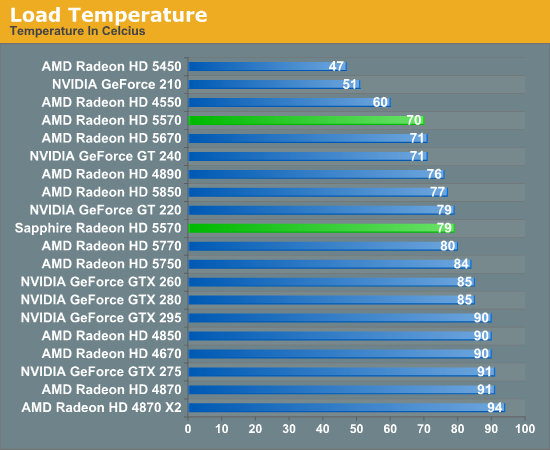
One thing you give up in moving to a smaller cooler for a low-profile card is the nice temperatures a full-profile card can attain. The 5570 ends up being several degrees warmer when idling when compared to the 5670, sharing company with our passive cards and some mid-range cards. Interestingly the Sapphire card does better here, coming in 3 degrees cooler at 40C.
Under load we have a different story. The 5570 marks a clear gap between passively cooled cards and actively cooled cards, but it enjoys the status of being our coolest actively cooled card. The Sapphire card on the other hand doesn’t do so well here, coming in at nearly 10C hotter. We believe that this is due to a combination of the difference in their fans and the use of a copper heatsink in the AMD reference card versus an aluminum heatsink in the Sapphire card. Unfortuantely we can’t tell which one has the bigger impact, since switching out a heatsink can improve the cooling performance without having an acoustic impact like switching out a fan does.
On a more speculative note, based particularly on the AMD card’s temperatures, the 5570 looks like a good candidate to get the passive treatment. It would likely need to be a full-sized card, but certainly it’s cool enough that someone should be able to build a passive Redwood card here.
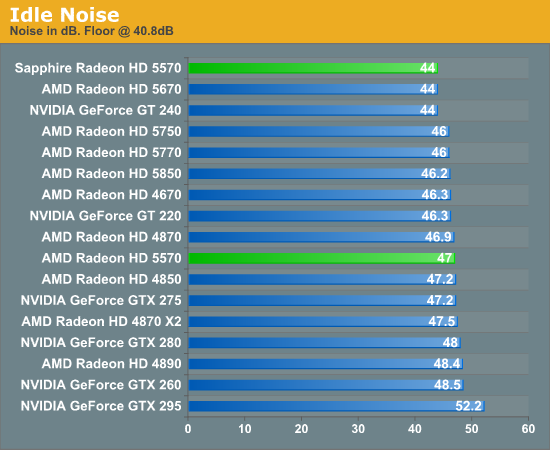
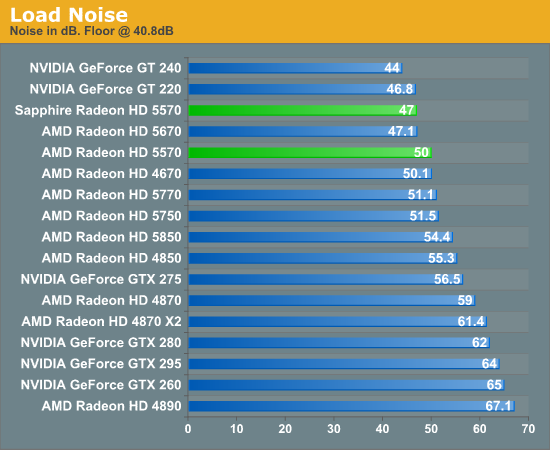
Despite the number of cards with small fans in our collection, the AMD 5570 stands out as having one of the loudest. Not only is it loud enough to do a bit worse at idle than a number of other cards (all of which tend to hug the noise floor), but it has just the right pitch to sound loud. We can easily tell it apart from all the other fans in our Spedo case, something that isn’t the case with several of these other cards. The fan on the Sapphire card on the other hand is as quiet as anything else we have tested when it comes to idling.
Under load the AMD card continues to be at a disadvantage. The more power-hungry cards end up being louder, but it’s still louder than the 4670 and even the 5670 (the latter of which is a surprisingly quiet card). The Sapphire on the other hand bests the 5670, but remember that the cost of this is that the Sapphire card hits nearly 80C under load. Sapphire’s card is clearly tuned for acoustics over thermals.










36 Comments
View All Comments
vlado08 - Tuesday, February 9, 2010 - link
Please give us comparison with intel HD graphics and also Ion in video post processing. Can we change gamma in intel drivers? Can we select different interlacing? Can we select the output RGB or YUV, 0-255 or 16-235? In some articles here on Anandtech you point intel HD as an perfect HTPC graphics? But is it really?Moizy - Tuesday, February 9, 2010 - link
I forgot that you included those screen shots of the 210 and the 220 doing the "cheese slices" test in the 5450 article. Thanks for pointing that out. I downloaded those screen-shots as well. Very useful for comparison.It's kind of irritating that they (AMD and nVidia) can't get the HTPC thing fully right unless you spend $100 and get a card that has a bunch of 3D capabilities that aren't needed if you just want to enjoy HD. I wonder, though, if half of the 5570's video-quality issues are driver-related and not hardware-related. As far as I know, the 4670 can handle all of the video-quality stuff, and 5570 seems very comparable hardware-wise.
mariush - Wednesday, February 10, 2010 - link
We wouldnt need these 100$ cards just to run a movie well if the crap that INTERLACING is would have been removed from the HD standard.Almost all the performace problems are caused by the need to deinterlace content. With progressive content, these cards don't have issues.
Slaimus - Tuesday, February 9, 2010 - link
The card really should be clocked at ~500Mhz with lower voltage, and maybe even 80 disabled SPs. All of that power wasting rendering ability is mostly idling while waiting for memory.MrSpadge - Tuesday, February 9, 2010 - link
Agreed. Although that could become a HD5550.wolrah - Tuesday, February 9, 2010 - link
Why do we still have VGA ports on these things? Those still using old-ass monitors can use an adapter off the DVI-I port that pretty much every video card includes for free. Give me DVI-I Dual Link, HDMI, and DisplayPort. VGA is dead and can be adapted with no downsides from other ports, there is no reason to keep putting that useless port there.Taft12 - Tuesday, February 9, 2010 - link
Spoken like someone who doesn't understand how every penny needs to be scrimped with the miniscule margins on these parts, especially given DVI royalties.MadMan007 - Tuesday, February 9, 2010 - link
You couldn't take a metal tool to the Sapphire heatsink to find out what material it is? I doubt it's actual 'paint' it's probably anodizing on aluminum which should be easy to scrape through.Ryan Smith - Tuesday, February 9, 2010 - link
I actually tried scraping through it, but I don't exactly have the right tool for the task. At any rate, Sapphire tells me it's Aluminum.shiggz - Tuesday, February 9, 2010 - link
Any idea if this card can handle MPCHC "sharpen complex 2" without stuttering on 720p files?